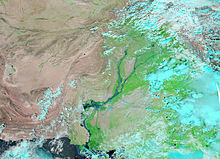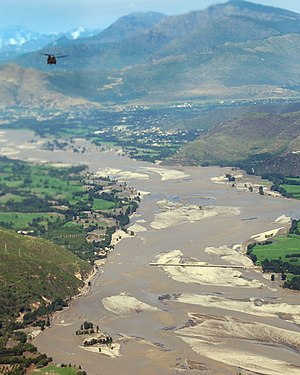|name=. Remove this parameter; the article title is used as the name by default. A NASA satellite image showing the Indus River at the time of floods | |
| Meteorological history | |
|---|---|
| Duration | 26 July 2010 – August 2010 |
| Overall effects | |
| Fatalities | 1,985[1] |
| Damage | $43 billion USD (estimated)[2][3][4] |
| Areas affected | Khyber Pakhtunkhwa, Punjab, Sindh, Balochistan and Gilgit-Baltistan |


The floods in Pakistan began in late July 2010, resulting from heavy monsoon rains in the Khyber Pakhtunkhwa, Sindh, Punjab and, Balochistan regions of Pakistan, which affected the Indus River basin. Approximately one-fifth of Pakistan's total land area was affected by floods, with the Khyber Pakhtunkhwa province facing the brunt of the damage and casualties (above 90% of all the deaths occurred in the province).[5][6][7][8] Nationwide, there were 1,985 deaths.[1] According to Pakistani government data, the floods directly affected about 20 million people, mostly by destruction of property, livelihood and infrastructure.[9]
UN Secretary-General Ban Ki-moon had initially asked for US$460 million (€420 million) for emergency relief, noting that the flood was the worst disaster he had ever seen. Only 20% of the relief funds requested had been received on 15 August 2010.[10] The U.N. had been concerned that aid was not arriving fast enough, and the World Health Organization reported that ten million people were forced to drink unsafe water.[11] The Pakistani economy was harmed by extensive damage to infrastructure and crops.[12] Damage to structures was estimated to exceed US$4 billion (€2.5 billion), and wheat crop damages were estimated to be over US$500 million (€425 million).[13] Total economic impact may have been as much as US$43 billion (€35 billion).[3][4]
- ^ a b UN Office for Disaster Risk Reduction; Centre for Research on the Epidemiology of Disasters. "Human cost of disasters - An overview of the last 20 years 2000-2019" (PDF).
- ^ Hyder, Kamal. "As Pakistan drowns, its leaders fight". Al-Jazeera TV News website. Archived from the original on 1 August 2018. Retrieved 23 November 2021.
- ^ a b "Pakistan evacuates thousands in flooded south". Yahoo! News. Archived from the original on 25 August 2010. Retrieved 24 August 2010.
- ^ a b "Pakistan battles economic pain of floods". Jakarta Globe. 19 August 2010. Archived from the original on 27 September 2010. Retrieved 24 August 2010.
- ^ The 2010 Floods – A case study, by Professor Nadeem Chaudhry
- ^ "Millions of Pakistan children at risk of flood diseases". BBC News. 16 August 2010. Archived from the original on 16 August 2010. Retrieved 16 August 2010.
- ^ Goodwin, Liz. "One-fifth of Pakistan under water as flooding disaster continues". Yahoo! News. Archived from the original on 24 August 2010. Retrieved 24 August 2010.
- ^ "The International Monetary Fund says the floods which have devastated Pakistan will present a massive economic and political challenge to its government and people". Radionz.co.nz. 22 August 2010. Retrieved 24 August 2010.
- ^ Cite error: The named reference
srcwas invoked but never defined (see the help page). - ^ "UN chief: Pakistan needs more aid". Al Jazeera. 15 August 2010. Retrieved 10 February 2011.
- ^ MacFarquhar, Neil (18 August 2010). "U.N. Warns of Supply Shortage in Pakistan". The New York Times. Retrieved 18 August 2010.
- ^ "Floods to hit economic growth: Finance Ministry". Dawn News. 10 August 2010. Archived from the original on 11 August 2010. Retrieved 10 August 2010.
- ^ "Preliminary Damage Estimates for Pakistani Flood Events, 2010" (PDF). Ball State University Center for Business and Economic Research. August 2010. Archived from the original (PDF) on 19 July 2011. Retrieved 18 August 2010.